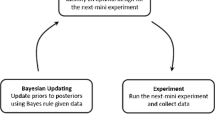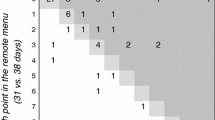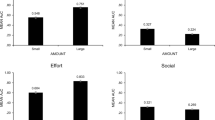Abstract
Temporal discounting rates have become a popular dependent variable in social science research. While choice procedures are commonly employed to measure discounting rates, equivalent present value (EPV) procedures may be more sensitive to experimental manipulation. However, their use has been impeded by the absence of test-retest reliability data. Staff and students at a regional Australian university (n = 53) participated in a matching EPV temporal discounting procedure in 2 sessions, 2 weeks apart, completing 30 one-shot, second-price auctions for two amounts, with delays ranging from 1–43 days. Discounting rates were estimated using hyperbolic and exponential models, as well as atheoretical area under the curve (AuC) analyses. Test-retest (relative) stability of the EPV procedure compared favorably with choice procedures (r =.75). Where discounting rates are used as a dependent variable, brief EPV procedures combined with atheoretical analyses of discounting rates are a more sensitive means to detect subtle experimental effects.
Similar content being viewed by others
References
AHLBRECHT, M., & WEBER, M. (1997). An empirical study on intertemporal decision making under risk. Management Science, 43, 813–826. doi:10.1287/mnsc.43.6.813
AINSLIE, G. (2001). Break-down of will. New York: Cambridge University Press.
AINSLIE, G. (2002, August). The effect of hyperbolic discounting on personal choices. Paper presented at the Annual Convention of the American Psychological Association, Chicago, IL. retrieved from http://www.picoeconomics.org/Articles/Apa.pdf
AINSLIE, G. (2009). Recursive self-prediction In self-control and its failure. In T. Grune-Yanoff & S. Ove Hansson (Eds.), Preference change: Approaches from philosophy, economics and psychology (Vol. A, pp. 139–158). Heidelberg: Springer.
BAKER, F., JOHNSON, M. W., & BICKEL, W. K. (2003). Delay discounting In current and never-before cigarette smokers: Similarities and differences across commodity, sign, and magnitude. Journal of Abnormal Psychology, 112(3), 382–392. doi:10.1037/0021-843X.112.3.38
BECK, R. C., & TRIPLETT, M. F. (2009). Test-retest reliability of a group-administered paper-pencil measure of delay discounting. Experimental and Clinical Psychopharmacology, 17(5), 345–355. doi:10.1037/a0017078
BELSLEY, D. A., KUH, E., & WELSCH, R. E. (1980). Regression diagnostics. New York: Wiley.
BENJAMIN, D., CHOI, J. J., & FISHER, G. (2010). Religious identity and economic behaviour. unpublished manuscript, Institute for Social Research, Cornell university, Ithaca, NY.
BICKEL, W. K., & JOHNSON, M. W. (2003). Delay discounting: A fundamental behavioral process of drug dependence. In G. Loewenstein, D. Read, & R. F. Baumeister (Eds.), Time and decision: Economic and psychological perspectives on intertemporal choice (pp. 419–440). New York: Russell Sage Foundation.
CHAPMAN, G. B. (1996). Temporal discounting and utility for health and money. Journal of Experimental Psychology: Learning, Memory, and Cognition, 22(3), 771–791. doi:10.1037/02787393.22.3.771
CHAPMAN, G. B., & ELSTEIN, A. S. (1995). Valuing the future: Temporal discounting of health and money. Medical Decision Making, 15(4), 373–386. doi:10.1177/0272989X9501500408
COOK, R. D. (1977). Detection of influential observation In linear regression, Technometrics, 19(1), 15–18.
COX, C. (2005). Examining the effects of ego depletion on temporal discounting. Salem, NC: Wake Forest University.
CRITCHFIELD, T. S., & KOLLINS, S. H. (2001). Temporal discounting: Basic research and the analysis of socially important behavior. Journal of Applied Behavior Analysis, 34(1), 101–122. doi:10.1901/jaba.2001.34-101
CURRY, O. S., PRICE, M. E., & PRICE, J. G. (2008). Patience is a virtue: Cooperative people have lower discount rates. Personality and Individual Differences, 44(3), 780–785. doi:10.1016/j.paid.2007.09.023
FREDERICK, S., LOEWENSTEIN, G., & O’DONOGHUE, T. (2003). Time discounting and time preference: A critical review. In G. Loewenstein, D. Read, & R. F. Baumeister (Eds.), Time and decision: Economic and psychological perspectives on intertemporal choice (pp. 13–88). New York: Russell Sage Foundation.
GRACE, R. C. (1999). The matching law and amount-dependent exponential discounting as accounts of self-control choice. Journal of the Experimental Analysis of Behavior, 71(1), 27. doi:10.1901/jeab.1999.71-27
GREEN, L., FRY, A. F., & MYERSON, J. (1994). Discounting of delayed rewards: A life-span comparison. Psychological Science, 5(1), 33–36. doi:10.1111/j.1467-9280.1994.tb00610
GREEN, L., MYERSON, J., LICHTMAN, D., ROSEN, S., & FRY, A. (1996). Temporal discounting In choice between delayed rewards: The role of age and income. Psychology & Aging, 11(1), 79–84.
GREEN, L., MYERSON, J., & MCFADDEN, E. (1997). Rate of temporal discounting decreases with amount of reward. Memory & Cognition, 25(5), 715–723.
HARDISTY, D. J., & WEBER, E. U. (2009). Discounting future green: Money vs. the environment. Journal of Experimental Psychology: General, 138(3), 329–340. doi:10.1037/a001643
HARRISON, J. M. D., & MCKAY, R. T. (2010). A hypothetical study of the relations between moral foundations, self reflection and temporal discounting. Manuscript In preparation, School of Psychology, Charles Sturt University, New South Wales, Australia.
HERRNSTEIN, R. J. (1958). Some factors influencing behaviour In a two-response situation. Transactions of the New York Academy of Sciences, 21, 35–45.
HIGHHOUSE, S., MOHAMMED, S., & HOFFMAN, J. R. (2002). Temporal discounting of strategic issues: Bold forecasts for opportunities and threats. Basic & Applied Social Psychology, 24(1), 43–56. doi:10.1207/S15324834basp2401_4
JOHNSON, M. W., BICKEL, W. K., & BAKER, F. (2007). Moderate drug use and delay discounting: A comparison of heavy, light, and never smokers. Experimental & Clinical Psychopharmacology, 15(2), 187–194. doi:10.1037/1064-1297.15.2.187
KAHNEMAN, D., & TVERSKY, A. (1979). Prospect theory: An analysis of decision under risk. Econometrica, 47, 263–291.
KEENE, O. (1995). Log transformation is special. Statistics In Medicine, 14(8), 811–819. doi:10.1002/sim.4780140810
KIRBY, K. N. (1997). Bidding on the future: Evidence against normative discounting of delayed rewards. Journal of Experimental Psychology: General, 126(1), 54–70. doi:10.1037/0096-3445.126.1.54
KIRBY, K. N. (2000). Instructions for inferring discount rates from choices between immediate and delayed rewards. Unpublished manuscript. Williams College, Williamstown, MA.
KIRBY, K. N. (2006). The present values of delayed rewards are approximately additive. Behavioural Processes, 72(3), 273–282. doi:10.1016/j.beproc.2006.03.011
KIRBY, K. N. (2009). One-year temporal stability of delay-discount rates. Psychonomic Bulletin & Review, 6, 457–462. doi:10.3758/Pbr.16.3.457
KIRBY, K. N., & MARAKOVIC, N. N. (1996). Delay-discounting probabilistic rewards: Rates decrease as amount increases. Psychonomic Bulletin and Review, 3, 100–104. doi:10.3758/Bf03210748
KIRBY, K. N., & SANTIESTEBAN, M. (2003). Concave utility, transaction costs, and risk In measuring discounting of delayed rewards. Journal of Experimental Psychology: Learning, Memory & Cognition, 29(1), 66–79. doi:10.1037/0278-7393.29.1.66
KIRBY, K. N., WINSTON, G. C., & SANTIESTEBAN, M. (2005). Impatience and grades: Delay-discount rates correlate negatively with college Gpa. Learning & Individual Differences, 15(3), 213–222. doi:10.1016/j.lindif.2005.01.003
LEBOEUF, R. A. (2006). Discount rates for time versus dates: The sensitivity of discounting to time-interval description. Advances In Consumer Research, 33(1), 138. doi:10.1509/jmkr.43.1.59
LOEWENSTEIN, G., & PRELEC, D. (1992). Anomalies In intertemporal choice: Evidence and an interpretation. Quarterly Journal of Economics, 107(2), 573–597. doi:10.2307/2118482
MADDEN, G. J., & BICKEL, W. K. (Eds). (2010). Impulsivity: The behavioral and neurological science of discounting (1st ed.). Washington, DC: American Psychological Association.
MAZUR, J. E. (1987). An adjusting procedure for studying delayed reinforcement. In M. L. Commons, J. E. Mazur, J. A. Nevin, & H. Rachlin (Eds.), Quantitative analyses of behavior: The effect of delay and intervening events on reinforcement value (Vol. 5, pp. 55–73). Hillsdale, NJ: Erlbaum.
MITCHELL, S. H. (1999). Measures of impulsivity In cigarette smokers and non-smokers. Psychopharmacology, 146(4), 455–464. doi:10.1080/146222004123312960023
MULLER, K. E., & MOK, M. C. (1977). The distribution of Cook’s D statistic. Communications In Statistics: Theory and Methods, 26(3), 525–546.
MYERSON, J., GREEN, L., & WARUSAWITHARANA, M. (2001). Area under the curve as a measure of discounting. Journal of the Experimental Analysis of Behavior, 76, 235–243. doi:10.1901/jeab.2001.76-235
ODUM, A. L., & BAUMANN, A. A. L. (2010). Delay discounting: State and trait variable. In G. J. Madden & W. K. Bickel (Eds.), Impulsivity: The behavioral and neurological science of discounting (1st ed., pp. 39–66). Washington, DC: American Psychological Association.
ODUM, A. L., MADDEN, G. J., & BICKEL, W. K. (2002). Discounting of delayed health gains and losses by current, never- and ex-smokers of cigarettes. Nicotine & Tobacco Research, 4(3), 295–303. doi:10.1080/14622200210141257
OHMURA, Y., TAKAHASHI, T., KITAMURA, N., & WEHR, P. (2006). Three-month stability of delay and probability discounting measures. Experimental and Clinical Psychopharmacology, 14(3), 318–328. doi:10.1037/1064-1297.14.3.318
ONG, E. L., & WHITE, K. G. (2004). Amount-dependent temporal discounting? Behavioural Processes, 66(3), 201–212. doi:10.1016/j.beproc.2004.03.00
OSTASZEWSKI, P., GREEN, L., & MYERSON, J. (1998). Effects of inflation on the subjective value of delayed and probabilistic rewards. Psychonomic Bulletin and Review, 5(2), 324–333. doi:10.3758/Bf03212959
PERLMUTTER, M. (1979). Age differences In adults’ free recall, cued recall, and recognition. Journal of Gerontology, 34(4), 533–539. doi:10.1093/geronj/34.4.533
RACHLIN, H., & GREEN, L. (1972). Commitment, choice and self control. Journal of the Experimental Analysis of Behavior, 17(1), 15–22.
READ, D., FREDERICK, S., ORSEL, B., & RAHMAN, J. (2005). Four score and seven years from now: The date/delay effect In temporal discounting. Management Science, (9), 1326–1335. doi:10.1287/mnsc.1050.041
READ, D., & ROELOFSMA, P. H. M. P. (2003). Subadditive versus hyperbolic disounting: A comparison of choice and matching. Organisation Behavior and Human Decision Processes, 91, 140–153. doi:10.1016/S0749-5978(03)00060-8
REED, D. D., & MARTENS, B. K. (2011). Temporal discounting predicts student responsiveness to exchange delays In a classroom token system. Journal of Applied Behavior Analysis, 44(1), 1–18. doi:10.1901/jaba.2011.44
REIMERS, S., MAYLOR, E. A., STEWART, N., & CHATER, N. (2009). Associations between a one-shot delay discounting measure and age, income, education and real-world impulsive behavior. Personality & Individual Differences, 47(8), 973–978. doi:10.1016/j.paid.2009.07.02
SCHWEIGHOFER, N., SHISHIDA, K., HAN, C. E., OKAMOTO, Y., TANAKA, S. C., YAMAWAKI, S., Et Al. (2006). Humans can adopt optimal discounting strategy under real-time constraints. Plos Computational Biology, 2(11), 1349–1356. doi:10.1371/journal.pcbi.0020152
SIMPSON, C. A., & VUCHINICH, R. E. (2000). Reliability of a measure of temporal discounting. Psychological Record, 50(1), 3–16.
THALER, R. (1981). Some empirical evidence on dynamic inconsistency. Economics Letters, 8(3), 201–207. doi:10.1016/0165-1765(81)90067-7
VAN DER POL, M. M., & CAIRNS, J. A. (2000). Negative and zero time preference for health. Health Economics, 9(2), 171–175. doi:10.1002/(Sici)1099- 1050(200003)9:2<171
VICKREY, W. (1961). Counterspeculation, auctions, and competitive sealed tenders. Journal of Finance, 16, 8–37.
VON NEUMANN, J., & MORGENSTERN, O. (1953). Theory of games and economic behavior (3rd ed.). Princeton, NJ: Princeton University Press.
WHELAN, R., & MCHUGH, L. A. (2009). Temporal discounting of hypothetical monetary rewards by adolescents, adults, and older adults. The Psychological Record, 59, 247–258.
WILEYTO, E. P. (2004). Mcqscore: Stata module to score the Monetary Choice Questionnaire using logistic regression. Boston College Department of Economics: Statistical Software Components.
WILSON, M., & DALY, M. (2003). Do pretty women inspire men to discount the future? Proceedings of the Royal Society B: Biological Sciences (Biology Letters), 271, 177–179. doi:10.1098/rsbl.2003.013
Author information
Authors and Affiliations
Corresponding author
Rights and permissions
About this article
Cite this article
Harrison, J., McKay, R. Delay Discounting Rates are Temporally Stable in an Equivalent Present Value Procedure Using Theoretical and Area under the Curve Analyses. Psychol Rec 62, 307–320 (2012). https://doi.org/10.1007/BF03395804
Published:
Issue Date:
DOI: https://doi.org/10.1007/BF03395804




